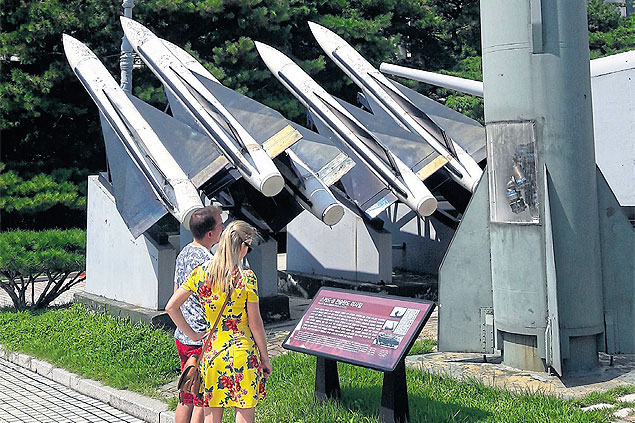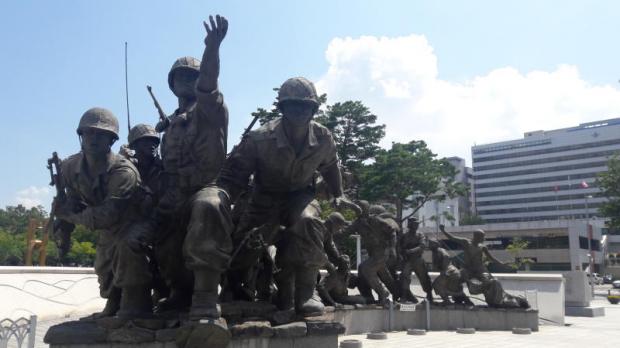
The sense that the Korean War is still being fought doesn't really kick in until you take a ride to the Demilitarized Zone (DMZ) that divides the Korean Peninsula in half. Barbed wire, fortified outposts and soldiers with guns are sure to get your attention in what former US president Bill Clinton once called "the scariest place on earth".
Now a tourist attraction where pistol shooting is among the offerings, the DMZ is only a two-hour drive from downtown Gwanghwamun Square in Seoul where the statue of the revered King Sejong the Great is situated.
After you pass the barbed wire and outposts along the Imjin River in Paju, where the North Korean People's Army tried to cross to invade Seoul in 1953, you will get to Dorasan (Dora Mountain). Above the well-constructed road leading up to a closed but still new immigration checkpoint, you will see a sign pointing straight to Pyongyang.
Along the way up Dorasan to the Dora Observatory, the northernmost point of the 247-kilometre land border known as the Military Demarcation Line, you will see red signs with white skull-and-crossbones warnings and the word "mine" every 50 or 100 metres. Spooky? Yes, but the mood changes when you get to the top. The presence of excited children, a gift shop and an ATM will certainly do that.
The first thing you will hear when you get to the observatory is South Korean news and K-Pop blasting from the speakers pointed toward North Korea to remind the neighbours what they're missing.
Of course, the North Koreans have signal-jamming towers but this doesn't deter the South Korean military, which runs the place, from trying to reach any North Korean who wants to listen.
This unyielding determination in the face of obstacles is what South Koreans are all about. They persevered through hardship under Japanese occupation and then World War II, before witnessing a fresh conflict that resulted in the country being torn into two.
Their resilience has lifted them up from the ashes of the Korean War to rich-country status in only a few decades, from an aid recipient to the largest Asian foreign-aid donor after Japan.
The current escalation of nuclear tension, which has captured the attention of a nervous world, is just another irritant. "We have been living which such provocation for a long time," Hwang Soon Sung, director of foreign press relations at the Foreign Ministry in Seoul, told Asia Focus.
His calm response reflected the mood in Seoul on Sept 3 after North Korea successfully conducted its sixth nuclear test, this time of a hydrogen bomb with an estimated yield of 100-150 kilotons, or 10 times larger than the last test on Sept 9, 2016. The bomb dropped by the US on Hiroshima had a yield of 15 kilotons. In light of these sobering facts, the seeming lack of concern on the streets of Seoul was remarkable.
AFTERMATH OF WAR
No one knows exactly how many people died in the four-year Korean War that ended in July 1953, but the Korea International Cooperation Agency has estimated more than 800,000 dead or missing.
Overall, 610,000 houses were destroyed and 7.6 million people were separated from their families. About 43% of South Korea's industrial facilities, 41% of its power-generating capacity and 312 kilometres of rail lines were destroyed, the agency said.
After the armistice was signed at Panmunjom, the US Congress approved the first installment of the Korean Relief Fund. In total, the country received around US$12.7 billion in foreign assistance, 70% of which was put to use from 1945 to 1960.
Cooperation with the rest of the world was a key to helping South Korea rebuild its economy and create the foundations for an industrial powerhouse.
Jobs were scarce during the 1960s and 1970s, and the government encouraged workers to go abroad to find work. Mines in West Germany were among those that welcomed many young Korean workers, who sent back much-needed foreign exchange and eventually returned home with valuable skills.
By 1993 the country was removed from the list of overseas development assistance (ODA) recipients, with a gross domestic product of $386.3 billion. Gross national income (GNI) that amounted to $3.96 billion and $120 per head in 1960 has since risen to $1.41 trillion and $27,600 respectively as of last year. That makes South Korea the fourth largest economy in Asia after China, Japan and India, despite a population of only 51 million.

Looking across the Demilitarized Zone from the Dora Observatory on the South Korean side. Erich Parpart
THE NUCLEAR PROBLEM
At the Dora Observatory, an outsider seeking to gauge the mood of average citizens asks visitors for their reaction to the escalating tensions of recent months. "We are used to it," a father accompanied by his children on a day trip tells Asia Focus.
Technically, the two Koreas are still at war and the DMZ, measuring four kilometres wide and serving as the de facto border, is the product of nothing more than a ceasefire agreement. The observatory looking across the zone is as close as you can get to the North without being underground in the so-called Third Tunnel.
The Third Tunnel is a North Korean infiltration route 1,635 metres in length, two metres in width and height, discovered by Seoul in 1978 and now another tourist attraction. The 500-person capacity observatory, meanwhile, is fitted with binoculars where visitors pay 500 won (15 baht) to take a rare glimpse into North Korea.
The front line here seems more peaceful than what is going on in the global political arena, where major powers are debating how to get North Korean leader Kim Jong-un and his regime back to the negotiating table,
Russia and China have always opposed Western sanctions on North Korea, saying they do not work and serve only to make the situation worse. Russian President Vladimir Putin made his view clear during a joint news conference with South Korean President Moon Jae-in on Sept 6.
After acknowledging that nuclear and missile tests were a flagrant violation of United Nations resolutions, Mr Putin said, "We should not act out of emotions and push North Korea into a dead end. ... We must act with calm and avoid steps that could raise tensions."
Chinese Premier Xi Jinping is still weighing his country's options, but observers do not think Beijing wants to support anything as dramatic as an embargo on oil shipments to North Korea, as that could simply result in more dangerous instability.

A monument at the War Memorial Museum of Korea in Seoul. Photo: Erich Parpart
The United States, meanwhile, has been busy conducting drills with South Korea and looking to sell more arms to both the South and Japan. Seoul last week swiftly moved to install four new Terminal High Altitude Area Defence (THAAD) rocket launchers on its territory despite protests from residents.
HR McMaster, national security adviser to US President Donald Trump, reaffirmed to his South Korean counterpart, Kim Kwan-jin, in April that Washington would shoulder the cost of deploying the THAAD system, days after Mr Trump said Seoul should pay for the $1-billion battery. No one knows what the unpredictable Mr Trump will ultimately decide, however.
Mr Trump's decision to blame Seoul's policy of "appeasement" while preparing to cancel a free trade agreement with the South certainly is poorly timed and will only play into the hands of the North as it tries to drive a wedge between South Korea and the US, former US officials and Korea experts say.
"The Trump administration is failing this test. Threats about the THAAD bill and now the trade agreement are very damaging," Jon Wolfsthal, a former special assistant to Barack Obama on non-proliferation, told The Guardian.
Kingston Reif, director for disarmament and threat reduction policy at the Arms Control Association, also said that "at a time when alliance unity and coordination are essential, it is hard to overstate how damaging and stupid this is".
But what are the other options? Maybe it is time for a mediator if the two sides still cannot get their act straight. Nikki Haley, the US ambassador to the United Nations, said on Sept 5 that Kim Jong-un was "begging for war" and "we have taken an incremental approach, and despite the best of intentions, it has not worked".
President Trump's infamous "fire and fury" remark and "enough is enough" from Ms Haley do not give the impression that Washington is willing to back down. And the rhetoric from Pyongyang is also reaching new heights of absurdity. Han Tae-song, ambassador of the Democratic People's Republic of Korea (DPRK) to the UN in Geneva, told a UN-sponsored conference on disarmament that "the recent self-defence measures by my country, are a gift package addressed to none other than the US", when referring to the latest nuclear test.
"The US will receive more gift packages from my country as long as it relies on reckless provocations and futile attempts to put pressure on the DPRK," he added without elaborating. Most experts believe, though, that the North is now holding out for a chance to negotiate. Swiss President Doris Leuthard offered on Sept 4 to have her country serve as a mediator in the crisis, a move welcomed by China.
Switzerland has maintained good relations with North Korea and the Kim family for some time as the current Supreme Leader attended a Swiss school in the suburb of Liebefeld outside Bern.
Furthermore, Switzerland is one of the few countries that still is providing aid to North Korea and has no plans to suspend its humanitarian support following fresh sanctions from the US and other European countries. But will Kim Jong-un pull the trigger before any sensible talk can take place?
"He (Kim Jong-un) will not pull the trigger because he will also be dead," is how Ji Seong-ho, a North Korean defector in Seoul, put it in an interview with Asia Focus.
"The reason why some North Korean people are now saying that they are ready to go to war is not because they want to go to war but because they are living in chaos with unimaginable suffering, to the point that they wish for all of this to be over already."